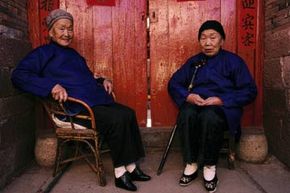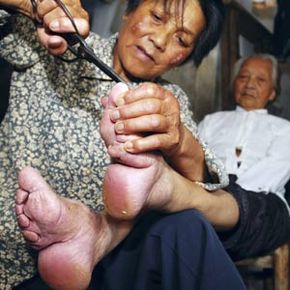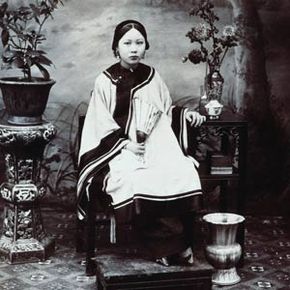The mincing steps. The swaying hips. The little nubbins at the ends of women's legs, carefully tucked into miniature, ornate shoes. For 1,000 years, tiny, curved feet were considered the ultimate standard of feminine beauty in China, leading about 3 billion Chinese womento bind their feet during this time, despite the fact that foot binding was a long, extremely painful process that resulted in severely deformed feet for life [source: Ross].
Several stories exist as to how the practice got started, but the most popular and credible says it began with Emperor Li Yu, who reigned during the Southern Tang dynasty (937-975 A.D.). In 970, the emperor reportedly saw his favorite consort dancing on a golden lotus pedestal and was entranced by her feet, which she had wrapped in strips of cloth -- much like those of a ballerina dancing on pointe -- so her dancing appeared more beautiful. Seeing the emperor's pleasure, other court maidens similarly wrapped their feet. Soon upper-class women adopted the fashion, and eventually it spread to all women, no matter their social status. Only a few regions resisted, like the Manchu and those who hailed from Guangdong in southern China [sources: Holman, Ross].
Advertisement
Unfortunately, as the custom took hold it morphed. Women wanted ever-smaller, more curved feet, and so the foot binding process was created to achieve highly arched, 3-inch (7.6-centimeter) feet. The practice thrived for 1,000 years until it was outlawed in 1912 after the revolution of Sun Yat-sen. However, women continued to bind their feet in parts of China until the late 1950s [sources: Evans, Minnesota-China Connection].
After the Communists came to power in 1949, women were forced to do hard physical labor like digging reservoirs, and those with bound feet found the work excruciating. They often went without food as they could not fulfill their daily production quota nor forage in the mountains for fruits like other women [source: Lim]. Today, foot binding is not practiced anywhere.
A 3-inch foot seems an impossibility. If you have the stomach, read on to see how it was achieved.
Advertisement





